
Andrea Mantegna was an Italian painter, a student of Roman archeology, and son-in-law of Jacopo Bellini.

Lorenzo Lotto was an Italian painter, draughtsman, and illustrator, traditionally placed in the Venetian school, though much of his career was spent in other north Italian cities. He painted mainly altarpieces, religious subjects and portraits. He was active during the High Renaissance and the first half of the Mannerist period, but his work maintained a generally similar High Renaissance style throughout his career, although his nervous and eccentric posings and distortions represented a transitional stage to the Florentine and Roman Mannerists.
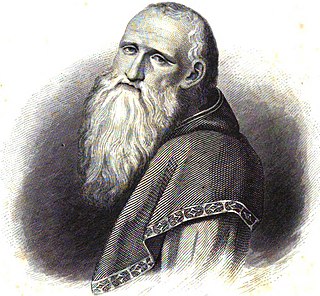
Bernardino Luini was a north Italian painter from Leonardo's circle during the High Renaissance. Both Luini and Giovanni Antonio Boltraffio were said to have worked with Leonardo directly; he was described as having taken "as much from Leonardo as his native roots enabled him to comprehend". Consequently, many of his works were attributed to Leonardo. He was known especially for his graceful female figures with elongated eyes, called Luinesque by Vladimir Nabokov.

Francesco del Cossa was an Italian Renaissance painter of the School of Ferrara, who after 1470 worked in Bologna. Cossa is best known for his frescoes, especially his collaboration with Cosimo Tura on a cycle of the months in the Palazzo Schifanoia of the Este family, rulers of Ferrara. Otherwise, his paintings are mostly of religious subjects, with some portraits and drawings attributed to him. He also designed stained glass.

Giovanni Battista Cima, also called Cima da Conegliano, was an Italian Renaissance painter, who mostly worked in Venice. He can be considered part of the Venetian school, though he was also influenced by Antonello da Messina, in the emphasis he gives to landscape backgrounds and the tranquil atmosphere of his works.

Vincenzo Foppa was an Italian painter from the Renaissance period. While few of his works survive, he was an esteemed and influential painter during his time and is considered the preeminent leader of the Early Lombard School. He spent his career working for the Sforza family, Dukes of Milan, in Pavia, as well as various other patrons throughout Lombardy and Liguria. He lived and worked in his native Brescia during his later years.

The Lamentation of Christ is a painting of about 1480 by the Italian Renaissance artist Andrea Mantegna. While the dating of the piece is debated, it was completed between 1475 and 1501, probably in the early 1480s. It portrays the body of Christ supine on a marble slab. He is watched over by the Virgin Mary, Saint John and St. Mary Magdalene weeping for his death.

The Pinacoteca di Brera is the main public gallery for paintings in Milan, Italy. It contains one of the foremost collections of Italian paintings from the 13th to the 20th century, an outgrowth of the cultural program of the Brera Academy, which shares the site in the Palazzo Brera.
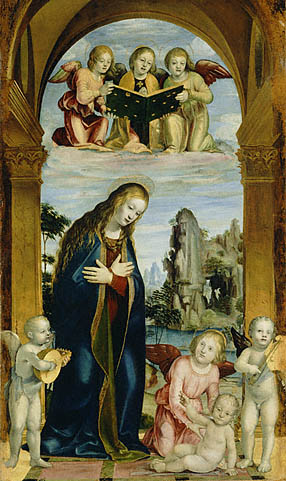
BernardoZenale was an Italian painter and architect.
The decade of the 1460s in art involved some significant events.
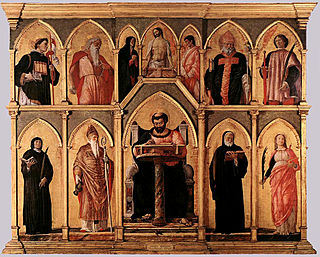
The San Lucas Altarpiece, also known as the San Lucas Polyptych, is a 1453 polyptych panel painting by Northern Italian Renaissance painter Andrea Mantegna. The altarpiece is a polyptych panel painting featuring 12 figures each in their own arch. The six figures in the top row flank the central figure of Jesus Christ. The four beneath flank Saint Luke.
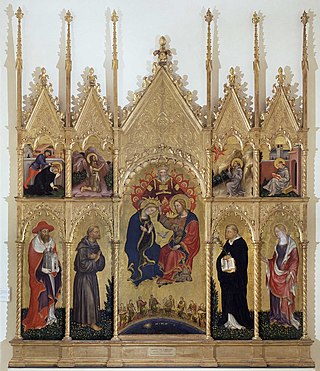
The Valle Romita Polyptych is a painting by the Italian late Gothic painter Gentile da Fabriano, dating from c. 1410-1412 and now housed in the Pinacoteca di Brera in Milan. It was originally executed for the Franciscan hermitage of Valle Romita near Gentile's birthplace, Fabriano.

The Chiesa di San Francesco is a Roman Catholic church located in the historic center of Mantua, Italy, at Piazza San Francesco d'Assisi 5.

The Pinacoteca del Castello Sforzesco is an art gallery in the museum complex of the Castello Sforzesco in Milan, northern Italy.
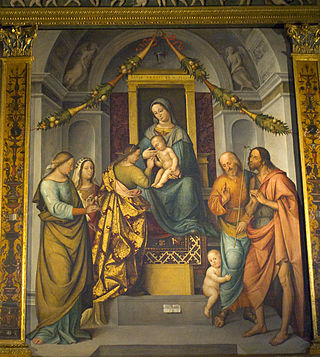
Francesco Verla was an Italian painter of the Renaissance period, active in Northern Italy.

Pietà or The Dead Christ Supported by the Virgin Mary and St John the Evangelist is a c. 1465–1470 tempera-on-panel painting by the Italian Renaissance artist Giovanni Bellini, now in the Pinacoteca di Brera in Milan.

The Greek Madonna is a 1460–1470 tempera-on-panel painting by the Italian Renaissance artist Giovanni Bellini. It is named after the Greek monograms at top left and top right and after the major influence of Byzantine icons on the painting. The Christ Child holds a golden apple, perhaps referring to the Judgement of Paris and to Mary as the "new Venus".
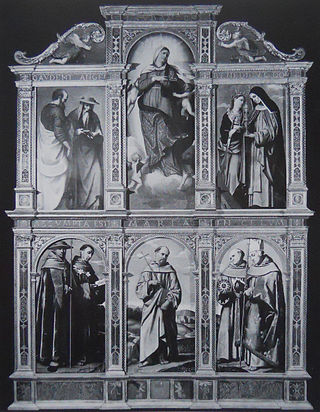
The Assumption Altarpiece was a 1529-1530 multi-panel painting by Moretto da Brescia. It is mainly oil on panel, although the two angels on the cornice are in tempera grassa verniciata.

















